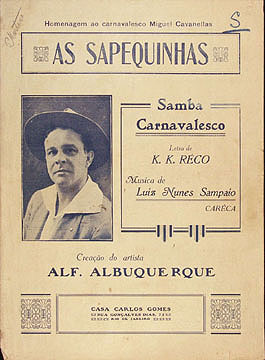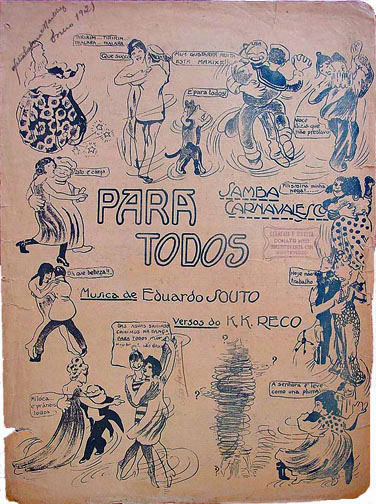The Boeuf chronicles, Pt. 25
A triple flourish caps the third cycle.
23 October 2002

Two views of Praça Tiradentes, theatrical center of Rio de JaneiroAt the time when Milhaud was living in Rio de Janeiro, many carnaval songs (indeed, most popular songs) were introduced to the public in vaudeville shows. The teatro de revista was a major public entertainment vehicle in the pre-gramophone, pre-radio era, and it furnished a good number of the tunes quoted in Le Boeuf sur le Toit.
The authors who wrote for the teatro de revista often had other occupations as well. Among the lyricists it was common to find journalists, some of whom specialized in writing humorous carnaval chronicles. In his book Figuras e Coisas do Carnaval Carioca (MEC-Funarte 1982), that ace of carnaval chroniclers Jota Efegê tells of the journalists of the K series—writers who adopted noms de plume beginning with the initial K. In that group we find K. Noa (canoe), K. Rapeta (a spinning top or a light lie), K. Peta (devil), K. Dete (cadet), K. K. Reco (junk), K. Ico (old mulatto), and K. Zinho.
Score published by Casa Carlos GomesA master of the K series was Norberto Bittencourt (K. K. Reco), the editor in charge of the sports and carnaval sections of the daily newspaper A Época. In 1919 he and composer Eduardo Souto had at least two songs in the carnaval: the cateretê (maxixe) “Seu Derfim Tem Que Vortá” and the samba carnavalesco “Para Todos.” The latter appears to have originated in a theatrical revue of the same name.
In his book Panorama da Música Popular Brasileira, 1.° Volume, Ary Vasconcelos presents this portrait of Eduardo Souto (1882–1942):
Eduardo SoutoEduardo Souto, descendant of an important family, was born in Santos, São Paulo, on 14 April 1882. At the age of eleven he came to Rio de Janeiro to study. Won over by music, he began to study it with Prof. Derbelly, making rapid progress. At 14 he presented his excited family with the waltz “Amorosa.”
As his family’s financial situation worsened, he was obliged to interrupt his engineering studies during his third year at the Escola Politécnica and to arrange employment at the Banco Francês. However, he continued to be fascinated by music, and went to visit the conductor José Nunes at Teatro S. José whenever he had free time. In 1917, he managed a music store in rua do Ouvidor. His masterpiece, “O Despertar da Montanha,” dates from 1919 and made him world-renowned. Souto conceived the Coral Brasileiro—whose members included famous personalities such as Bidu Sayão, Nascimento Silva, Zaíra de Oliveira, etc.—and organized the various orchestras that participated in the receptions for the Belgian king and queen on the occasion of their visit to Brazil in 1920. He founded [the music store/publishing house] Casa Carlos Gomes in rua Gonçalves Dias, which became the favorite meeting point of the great composers of that time. He was artistic director of Odeon and Parlophon. Orchestrator and conductor of symphonic music, he led concerts in Rio de Janeiro and São Paulo. Endowed with mystic tendencies, he was a member of esoteric and theosophist associations and even composed under the influence. His Bahian-style chula “Pemberê” (co-authored with João da Praia) was a success in the 1921 carnaval, and his samba “Tatu Subiu no Pau” was one of the most often sung in the 1923 carnaval. He wrote music for various revues, among them Zig Zag, in partnership with maestro Antônio Lago and words by Bastos Tigre (1926). Disenchantments with the musical milieu made him return to his old activity as banker. Ailing, he had to retire to a nursing home, where he died at exactly the age of 60. His son Nelson Souto, an excellent pianist, recorded in 1958 a memorable LP on the Festa label with his father’s tunes, including some of his delicious carnaval numbers.
Eduardo Souto score coverTune No. 25: “Para Todos” (1919)
Fundação Joaquim Nabuco’s database lists no fewer than 281 recordings of Eduardo Souto’s tunes, composed in a myriad of genres. However, the samba carnavalesco “Para Todos” isn’t one of them. Moreover, Norberto Bittencourt does not appears in the database even once.
As mentioned in the previous two Boeuf chronicles, Milhaud quotes “Para Todos” in a triple counterpoint that also includes “Seu Amaro Quer” and “Sertanejo.” It is difficult to distinguish in Louis de Froment’s recording,
and not much easier in Stephen Coombs & Artur Pizarro’s piano four-hands recording.
We must therefore rely on Manoel Aranha Corrêa do Lago’s description of the counterpoint in his notes for the Dover edition of Le Boeuf sur le Toit for Piano Four Hands:
In the last bars of section Z, page 50, the melody of Carlos Pagliuchi's Sertanejo appears in Piano 1, right hand, in superimposition to Eduardo Souto’s Para todos in the left hand, simultaneously with the original melody and accompaniment of Soriano Robert’s Seu amaro quer which appear, respectively, in the right and left hands of Piano 2.
See if you can recognize Milhaud’s quotation after having listened to Alexandre Dias’ recording of “Para Todos” from the original piano score.
The score was published by Eduardo Souto’s own Casa Carlos Gomes, just as so many of his tunes were recorded by Orquestra Eduardo Souto and by Grupo Eduardo Souto at Odeon, where he was artistic director. There is no indication why the line E até mais ver in the lyrics is flanked by asterisks.
Para Todos
Samba Carnavalesco
Offerecido ao Dr. Sylvio Romero F.°
M.D. Director da Revista “PARA TODOS”
Eduardo Souto
Versos de Norberto Bittencourt
(K. K. RÉCO)1a Parte
Trá-la-rá canta o clarim!
Já não ha mais tristeza!
E Momo emfim
Com realeza,
Vem ao festim...
Oh! que belleza!... (Côro)O tempo é de loucuras...
Carnaval de foliões!...
Em diabruras,
Os corações
Gozam doçuras...2a Parte
“Côro”
Surge a alegria
Tudo convida
Para a folia
Tiri-rim
Tiri-rim
Trá-la-rá
Trá-la-rá
Ah!..E os pretendentes
À presidencia,
Estão contentes
Tiri-rim
Tiri-rim
Trá-la-rá
Trá-lá...1a Parte
Com risos do labio a flor,
Gozemos a singeleza
Do nosso amor,
Com grandeza
E com fulgor...
Oh! que belleza. (Côro)Do champagne ao espoucar
Azo emfim vamos nos ter
Para folgar
*E até mais ver*
Toca a dançar...2a Parte
“Côro”
Surge a alegria, etc.The triple counterpoint marks the end of the third cycle of Le Boeuf sur le Toit. The first and the second cycles ended with mathematical precision, each following four iterations of the rondo theme, including a pair of quotations between iterations and featuring “Ferramenta” as the lead in the final pair. The third cycle follows precisely the same pattern:
Cycle I
Rondo 1
1. “São Paulo Futuro” (section A)
2. “São Paulo Futuro” (section B)
Rondo 2
1. “Viola Cantadeira” (section B)
2. “Viola Cantadeira” (section A)
Rondo 3
1. “Amor Avacalhado” (section A)
2. “O Matuto” (section B) + “O Boi no Telhado” (section A)
Rondo 4
1. “Ferramenta” (section A)
2. “Olh’ Abacaxi!” (section A)Cycle II
Rondo 5
1. “Gaúcho” [Corta-Jaca] (section A)
2. “Flor do Abacate” (section A)
Rondo 6
1. “Tristeza de Caboclo” (sections A+B)
2. “Maricota, Sai da Chuva” (section A)
Rondo 7
1. “Carioca” (section A) + “Escovado” (section A)
2. “Escovado” (section A) + “Carioca” (section A)
Rondo 8
1. “Ferramenta” (section A)
2. Waltz [unknown no. 1]Cycle III
Rondo 9
Le Boeuf sur le Toit is approaching its conclusion. All that’s left is the recapitulation, followed by the coda—three tunes to go.
1. “La Mort du Policeman” [unknown no. 2] + Tanguinho meio choro [unknown no. 3]
2. “Caboca di Caxangá” (intro) + “Vamo Maruca, Vamo” (section B)
Rondo 10
1. “O Matuto” (section A) + “Caboca di Caxangá” (refrain)
2. “A Mulher do Bode” (section A) + “Urubú Subiu” (intro) + “Vamo Maruca, Vamo” (section A)
Rondo 11
1. “Tango Brasileiro” (section B)
2. “Que Sodade” (section A)
Rondo 12
1. “Ferramenta” (section A)
2. “Seu Amaro Quer” (section A) + “Sertanejo” (section A) + “Para Todos” (section A)
Copyright © 2002–2016 Daniella Thompson. All rights reserved.







